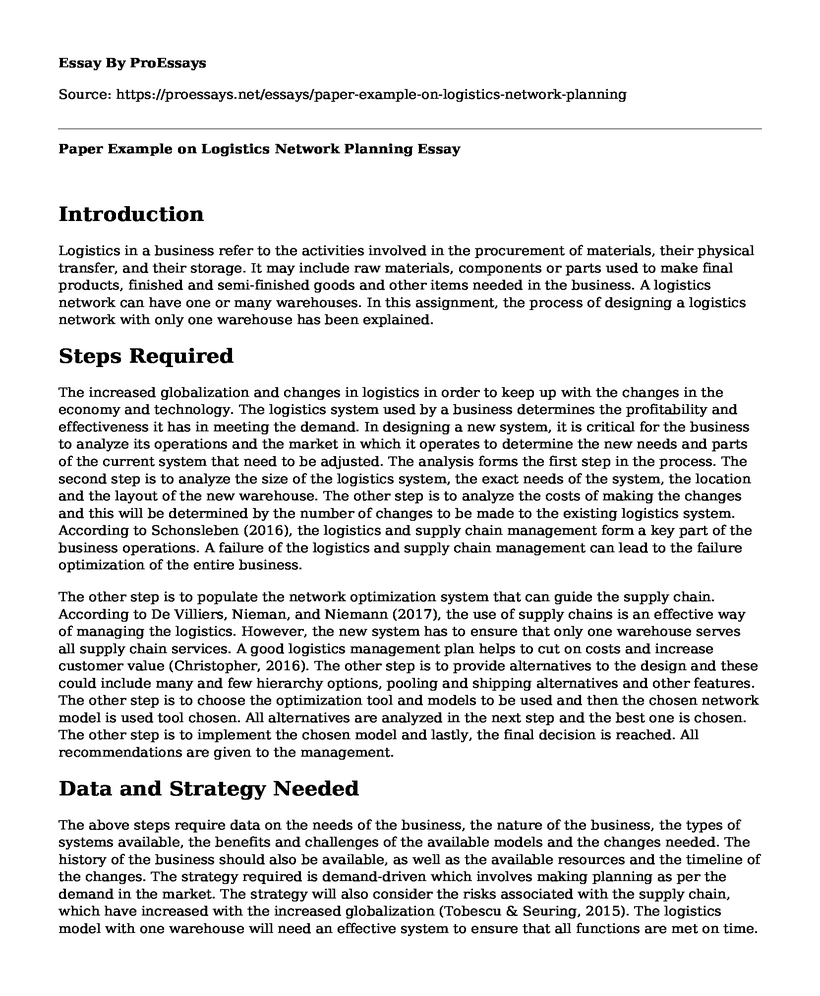Introduction
Logistics in a business refer to the activities involved in the procurement of materials, their physical transfer, and their storage. It may include raw materials, components or parts used to make final products, finished and semi-finished goods and other items needed in the business. A logistics network can have one or many warehouses. In this assignment, the process of designing a logistics network with only one warehouse has been explained.
Steps Required
The increased globalization and changes in logistics in order to keep up with the changes in the economy and technology. The logistics system used by a business determines the profitability and effectiveness it has in meeting the demand. In designing a new system, it is critical for the business to analyze its operations and the market in which it operates to determine the new needs and parts of the current system that need to be adjusted. The analysis forms the first step in the process. The second step is to analyze the size of the logistics system, the exact needs of the system, the location and the layout of the new warehouse. The other step is to analyze the costs of making the changes and this will be determined by the number of changes to be made to the existing logistics system. According to Schonsleben (2016), the logistics and supply chain management form a key part of the business operations. A failure of the logistics and supply chain management can lead to the failure optimization of the entire business.
The other step is to populate the network optimization system that can guide the supply chain. According to De Villiers, Nieman, and Niemann (2017), the use of supply chains is an effective way of managing the logistics. However, the new system has to ensure that only one warehouse serves all supply chain services. A good logistics management plan helps to cut on costs and increase customer value (Christopher, 2016). The other step is to provide alternatives to the design and these could include many and few hierarchy options, pooling and shipping alternatives and other features. The other step is to choose the optimization tool and models to be used and then the chosen network model is used tool chosen. All alternatives are analyzed in the next step and the best one is chosen. The other step is to implement the chosen model and lastly, the final decision is reached. All recommendations are given to the management.
Data and Strategy Needed
The above steps require data on the needs of the business, the nature of the business, the types of systems available, the benefits and challenges of the available models and the changes needed. The history of the business should also be available, as well as the available resources and the timeline of the changes. The strategy required is demand-driven which involves making planning as per the demand in the market. The strategy will also consider the risks associated with the supply chain, which have increased with the increased globalization (Tobescu & Seuring, 2015). The logistics model with one warehouse will need an effective system to ensure that all functions are met on time.
Conclusion
In conclusion, the changes in the logistics system should be done in a way that the business achieves its aims. The change from many warehouses to a single one is a critical move and requires planning and good implementation. The steps followed in the designing of the new logistics system are given in a logical order and they guide the designing and implementation process.
References
Christopher, M. (2016). Logistics & supply chain management. Pearson UK.
De Villiers, G., Nieman, G., & Niemann, W. (Eds.). (2017). Strategic logistics management: A supply chain management approach. Van Schaik Publishers.
Schonsleben, P. (2016). Integral logistics management: operations and supply chain management within and across companies. CRC Press.
Tobescu, C., & Seuring, S. (2015). Internal Enablers for the Implementation of Sustainable Supply Chain Risk Management Systems. In Logistics Management (pp. 17-26). Springer, Cham.
Cite this page
Paper Example on Logistics Network Planning. (2022, Jul 16). Retrieved from https://proessays.net/essays/paper-example-on-logistics-network-planning
If you are the original author of this essay and no longer wish to have it published on the ProEssays website, please click below to request its removal:
- Management Essay Sample. William Henry Gates: Leadership in Microsoft
- Case Study: Joint Venture Between Health Snacks and Toka Foods
- A Discussion on Servant Leadership Paper Example
- Operational Analysis and Quality Improvement Paper Example
- Ethical and Moral Practices of Doing Business in Europe Paper Example
- Value-Based Leadership: a Necessity for Success - Essay Sample
- Essay on Prosperity via Fictitious or Honest Means: Reality Life's Unconditional Wedge







